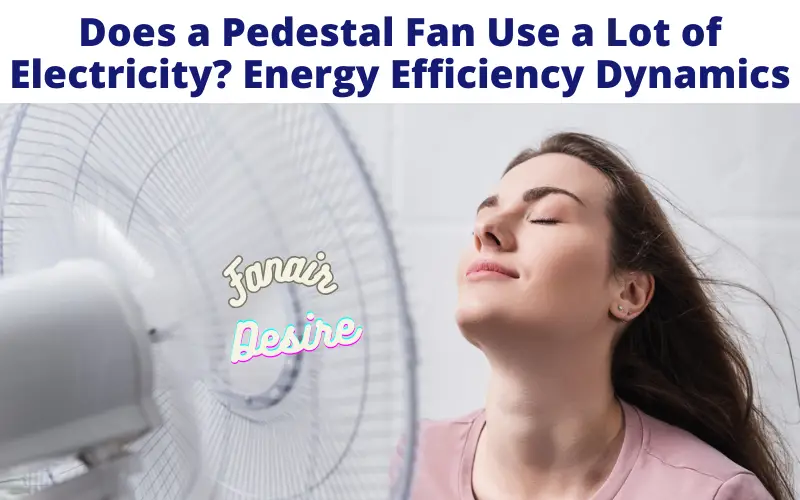Pedestal fans have long been a popular choice for keeping homes comfortable during the scorching summer months. These versatile appliances are celebrated for their ability to efficiently circulate air without the high energy costs associated with central air conditioning. Yet, a prevalent question among users is, does a pedestal fan use a lot of electricity?
In this thorough guide, we’ll explore the details of how pedestal fans consume energy, clarify prevalent misconceptions, and provide you with a wealth of knowledge to enhance your cooling experience in terms of both effectiveness and energy efficiency.
Does a Pedestal Fan Use a Lot of Electricity? Unveiling the Energy Efficiency Dynamics
Understanding Pedestal Fan Energy Consumption
Before we embark on our journey to unravel the energy consumption of pedestal fans, it’s crucial to establish a foundational understanding of how these devices operate and their impact on your electricity bill.
Demystifying Pedestal Fan Basics:
A typical pedestal fan consists of a circular blade assembly encased within a protective grill.
It stands on an adjustable-height pedestal, affording you the flexibility to customize the direction and intensity of the airflow.
The Mechanism Behind Pedestal Fans:
Pedestal fans operate by drawing in ambient air and propelling it forward, generating a cool and refreshing breeze.
Most models offer adjustable speed settings, enabling you to fine-tune the airflow according to your comfort preferences.
Measuring Energy Consumption: The Watts and Kilowatt-Hours Perspective
To ascertain whether a pedestal fan uses a substantial amount of electricity, we must delve into the world of electrical measurements, specifically watts and kilowatt-hours (kWh).
Watts (W): Watts represent the rate at which an electrical device consumes energy. A higher wattage signifies greater energy usage.
Kilowatt-Hours (kWh): Kilowatt-hours denote the total energy consumption over time. Your utility bill is calculated based on the number of kilowatt-hours you consume.
Does a Pedestal Fan Use a Lot of Electricity? Pedestal Fan Energy Consumption
Now, let’s explore the concrete facts about the energy consumption of pedestal fans:
Low Wattage Draw: Does a Pedestal Fan Use a Lot of Electricity?
Pedestal fans typically fall within the range of 30 to 100 watts, positioning them as remarkably energy-efficient appliances when juxtaposed with power-hungry alternatives like air conditioners.
Tailored Speed Control: Does a Pedestal Fan Use a Lot of Electricity?
The ability to adjust the fan’s speed allows you to strike a balance between effective cooling and minimal energy consumption. Lower settings consume significantly less electricity.
Intermittent Usage: Does a Pedestal Fan Use a Lot of Electricity?
Pedestal fans are often employed intermittently for shorter durations, unlike air conditioners that may run for hours on end without interruption.
Complementary Cooling:
By using a pedestal fan in tandem with your air conditioner, you can enhance your overall comfort while potentially reducing the load on your AC system. This, in turn, can translate into lower cooling costs.
Myth vs. Reality: Dispelling Common Electricity Usage Misconceptions
Let’s confront and dispel some prevailing myths regarding pedestal fans and their impact on electricity usage:
Myth 1: Pedestal fans are notorious energy hogs.
Reality: Pedestal fans are renowned for their energy-efficient performance, drawing considerably less electricity than most other cooling appliances.
Myth 2: Leaving a fan running when not in the room is an extravagant waste of energy.
Reality: While it is advisable to switch off fans when they are not actively contributing to your comfort, the low energy consumption of pedestal fans means that even occasional lapses in turning them off have a minimal impact on your energy bill.
Efficiency-Boosting Strategies for Pedestal Fan Use
To ensure that your pedestal fan operates at its peak efficiency, consider implementing these pragmatic strategies:
Strategic Placement: Does a Pedestal Fan Use a Lot of Electricity?
Position the fan strategically to maximize its cooling effect. Placing it near an open window, for example, can facilitate the inflow of fresh, cooler air, enhancing the overall cooling experience.
Speed Selection: Does a Pedestal Fan Use a Lot of Electricity?
Exercise thoughtful control over the fan’s speed settings. Utilize lower speeds for gentle and energy-efficient cooling, reserving higher speeds for exceptionally hot days or specific comfort requirements.
Timely Deactivation:
Cultivate a habit of switching off the fan when it is no longer required. This practice not only conserves energy but also extends the lifespan of your pedestal fan.
Regular Maintenance: Does a Pedestal Fan Use a Lot of Electricity?
Schedule routine cleaning and maintenance sessions to ensure your fan’s blades and motor remain free of dust and debris. A well-maintained fan operates more efficiently and consumes less energy.
Consider Timers:
Some pedestal fans come equipped with built-in timers, enabling you to preset specific operating durations. Leveraging timers can provide you with an added layer of energy management.
Conclusion: Striking the Balance Between Comfort and Economy
In conclusion, pedestal fans stand as a cost-effective and energy-efficient solution for staying cool during the summer months. While they do consume electricity, their energy usage is notably frugal in comparison to alternative cooling methods.
By adhering to the tips and insights provided in this guide, you can achieve a harmonious equilibrium between personal comfort and energy-consciousness. Rest assured, you can enjoy the refreshing benefits of your pedestal fan without burdening your energy bills excessively.

